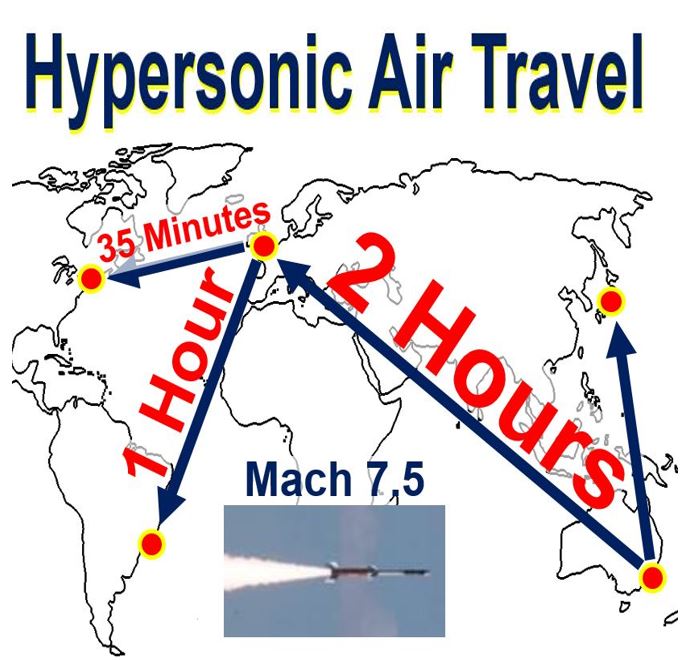Hypersonic flight that would cut a Sydney to London or London to New York trip to 2 hours and 35 minutes respectively is one step close, the Australian Department of Defence has announced, after a successful test flight was carried out at Woomera Test Range in north-west South Australia, about 450 kilometres NNW of Adelaide.
Dr. Alex Zelinsky, the Department’s Chief Defence Scientist, congratulated the American-Australian team on the success of the experimental hypersonic flight on Thursday.
 Imagine taking just two hours to get from Sydney to London, and a mere 35 minutes from London to New York. Perhaps there will be employees in future who work on one side of the Atlantic and commute to the other side each day.
Imagine taking just two hours to get from Sydney to London, and a mere 35 minutes from London to New York. Perhaps there will be employees in future who work on one side of the Atlantic and commute to the other side each day.
Mach 7.5 speed achieved
The experimental rocket reached the targeted speed of seven-and-a-half times the speed of sound, i.e. Mach 7.5 or 5,754 mph (9,261 km/h), and an apogee (maximum distance from Earth’s surface) of 278 km or 172 mph.
The test flight was performed as part of a joint research programme – HiFire, which stands for Hypersonic International Flight Research Experimentation Program – being conducted by aerospace company Boeing, the US Air Force Research Laboratory, the University of Queensland, and Australia’s Defence Science and Technology Group.
Dr. Zelinsky said:
“The success of this test launch takes us one step closer to the realisation of hypersonic flight.”
 The Defence Science and Technology Group (DST Group) is part of the Australia’s Department of Defence dedicated to providing science and technology support for the country’s defence and national security needs. It is Australia’s second largest publicly-funded science organisation after the CSIRO. (Image: twitter.com/DefenceScience)
The Defence Science and Technology Group (DST Group) is part of the Australia’s Department of Defence dedicated to providing science and technology support for the country’s defence and national security needs. It is Australia’s second largest publicly-funded science organisation after the CSIRO. (Image: twitter.com/DefenceScience)
Hypsersonic flight will transform air travel
Aircraft that can travel at hypsersonic speeds have the potential to completely transform the air transport industry, as well bring considerable economic and social benefits.
Dr. Zelinsky added:
“It is a game-changing technology identified in the 2016 Defence White Paper and could revolutionise global air travel, providing cost-effective access to space.”
The program’s aim is to explore which fundamental technologies are vital for the realisation of sustained hypersonic flight.
According to Kevin Bowcutt, Boeing’s Chief Scientist, the HIFiRE program will produce valuable scientific flight data which will significantly accelerate the development of operational hypersonic systems.
Regarding hypersonic air travel, Dr. Bowcutt said:
“It would readily change the world—like the cellphone and the computer—if we could routinely fly in and out of space.”
Professor Michael Smart, from the University of Queensland’s School of Mechanical and Mining Engineering, who specialises in hypersonic aerodynamics, scramjets and compressible fluid flow, praised the highly skilled program members and said they were placing his country’s aerospace industry on the international stage.
 The excitement following Thursday test flight globally has been palpable. (Image: twitter.com/BMRExpress)
The excitement following Thursday test flight globally has been palpable. (Image: twitter.com/BMRExpress)
Prof. Smart said:
“UQ is pleased to be part of a group of highly skilled individuals doing cutting edge research. We’re excited by the contributions this and future HIFiRE flights will make to the advancement of hypersonic flight technology.”
“The knowledge gained from these experiments will be applied to develop future flight vehicles and testing of advanced air-breathing hypersonic propulsion engines, known as scramjets.”
The HiFiRE programme has already achieved some major milestones, including the design, assembly and pre-flight testing of hypersonic vehicles, as well as the design of complex avionics and flight systems.
The team members say several test flights are planned to take place over the next two years. They believe it will not be long before the world has a commercially-viable hypersonic passenger transport service, which would completely change global travel.
Hypersonic vs. supersonic speeds
While the term hypersonic and supersonic both refer to high speed, their meanings are different.
– Hypersonic speed is anything over Mach 5, or five times the speed of sound – 6,174 km/h, 3,836 mph, or 8,439 feet per second.
– Supersonic speed is anything faster than the speed of sound, or Mach 1, i.e. 1,126 km/h, 768 mph, or 1,126 feet per second.
The only supersonic commercial passenger airplane so far was Concorde, which stopped operating in 2003. It reached a speed of 1,334 mph or 2,140 km/h.
A passenger aircraft that the HiFiRE programme hopes will emerge will travel more than seven times faster than Concorde.
Video – Prototype rocket reaches Mach 7.5
Prototype rocket HiFiRE 5B was launched from the Woomera Test Range in South Australia. On this (silent) video you can see footage of lift off from several different angles.

